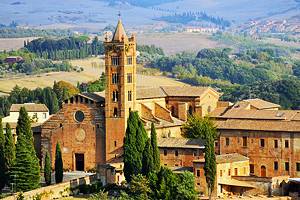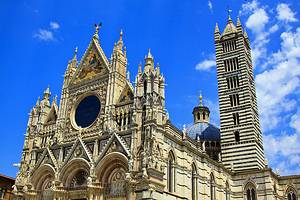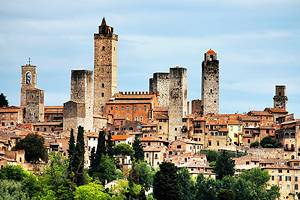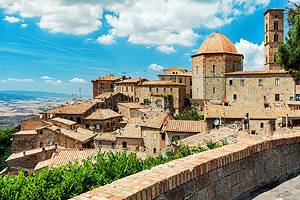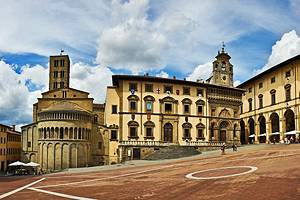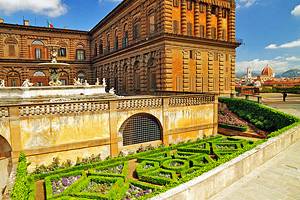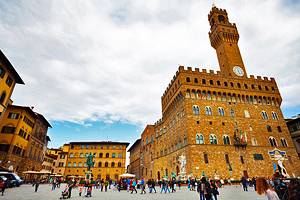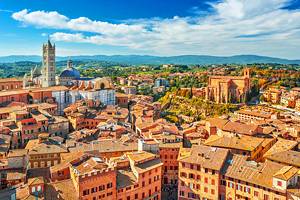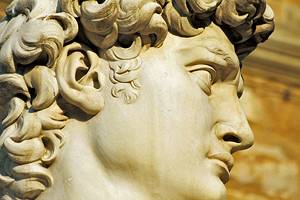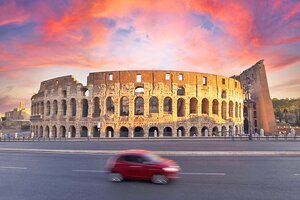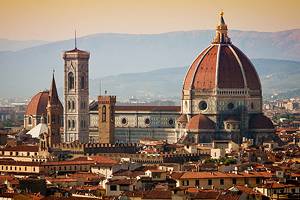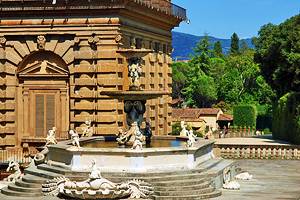Day Trips from Siena
Siena sits in the midst of Tuscany's hill country, within easy reach of a number of charming towns, many with walls that survive from as far back as Etruscan times. It was a favorite region for abbeys and monasteries, some still active, some closed with only their churches surviving, and one, the Abbey of San Galgano, standing roofless in romantic ruin.
Throughout this region are Romanesque churches with splendid medieval stone carving and a few notable artworks, but the main reason tourists love to explore here is to discover the hill towns. Set overlooking beautiful, undulating landscapes, these medieval villages are its main attractions.
Along with all the things to see and do in Siena itself, the city makes a good base for day trips to surrounding Tuscan towns. Although many of the abbeys and some of the towns are not on bus or rail lines, you can take trips from Siena without a car. The trip from Siena to Florence or San Gimignano is about an hour by train, and a bus to Arezzo takes just over an hour.
Discover the best places to visit in the region with our list of the top day trips from Siena.
Florence

It would be a shame to be so close and not spend some time in the Renaissance city of Florence. Some of the greatest achievements of that era are here-—Brunelleschi's soaring dome on the Cathedral of Santa Maria del Fiore, Ghiberti's bronze doors on the Baptistery, the stunning art collections of the Uffizi Gallery, Michelangelo's masterpieces in the Church of San Lorenzo, and the opulent palaces and museums.
The relatively small Centro Storico, where you'll find some of the most important masterpieces of Italian Renaissance art and architecture, is easy to reach from the train station, where more than a dozen trains a day arrive from Siena. If you're driving, plan on about 90 minutes, but remember that traffic and parking are both very difficult in Florence, so arriving into the heart of the city by train might be a better choice.
- Read More: Tourist Attractions in Florence
San Gimignano

The 13 tall, slender towers that mark the skyline of San Gimignano are its trademark, distinguishing it immediately from all the other postcard Tuscan hill towns. Its atmospheric medieval center is where you'll find these square towers, originally built as fortified homes and later becoming status symbols for rival noble families. Several surround the three-sided main square, Piazza della Cisterna, and there are more on Via del Castello, and two looking down onto Piazza del Duomo.
The church on this piazza is not the Duomo—there is no cathedral here and never has been—but Santa Maria Assunta, a Romanesque church built in the 12th century and enlarged in the 15th century. The interior is brightened by an outstanding group of fresco cycles.
- Read More: Attractions & Things to do in San Gimignano
Montepulciano

Enclosed by walls and looking much the same as it did in the 16th century, Montepulciano is a lovely mix of medieval and Renaissance architecture with a bit of Baroque added in some of its churches. This legacy of fine craftsmanship resulted from the many noble families residing here, who retained their importance—and fortunes—longer than in many other Tuscan cities. As medieval gave way to Renaissance tastes, leading architects and artists came to Montepulciano to work for these wealthy patrons.
Arezzo

Just over an hour from Siena by bus, Arezzo is a former Roman military outpost that has nurtured the arts and attracted artists since its early days. Medieval and Renaissance artists left their marks in its churches, where you'll see beautiful frescoes, terra-cotta work, marble carvings, altar paintings, gold work, enamels, and magnificent stained glass windows.
Highlights of Arezzo are the 13th-century Cimabue Crucifix in the church of San Doménico, the stained glass in the Duomo, the fresco cycle by Piero della Francesca in the church of San Francesco, and his fresco The Magdalene in the Duomo. To look back further into Arezzo's long history, visit the Archaeological Museum, where exhibits delve into its Etruscan and Roman past.
Monte Oliveto Maggiore

One of the most renowned monasteries of the Olivetans, an independent branch of the Benedictines, the large monastery of Monte Oliveto Maggiore was founded in 1313 by Bernardo Tolomei. The abbey soon developed into a flourishing monastery, was several times enlarged, and became a center of spiritual and cultural life. Even today, it is the home of an active monastic community.
You will enter through a fortress-like gate tower, begun in 1393, with terra-cotta reliefs by the school of Luca della Robbia. The abbey's brick buildings were erected in stages between 1387 and 1514, with some later restoration. The imposing early-15th-century church is known for its remarkably beautiful choir-stalls, 125 individual works of art created in intricate wood inlay by Giovanni da Verona from 1503 to 1505.
In the cloister are outstanding frescoes showing 35 scenes from the life of St. Benedict, founder of the Benedictine Order. Nine are by Luca Signorelli, done from 1479 onwards, and the rest were done after 1505 by Sodoma. You can also tour the library, the pharmacy, and the chapter-house with a monk as a guide.
Location: Monte Oliveto Maggiore, Asciano Siena
Pienza

The UNESCO World Heritage town of Pienza is a highlight of the beautiful Val d'Orcia, which it overlooks from a high prominence. The views in every direction made it an early strategic location, but it was native son Enea Silvio Piccolomini, who later became Pope Pius II, who made it the attraction it is today.
A great humanist, Piccolomini set about transforming the hilltop village into a Utopian city, embodying classical principles and the ideals of the Italian Renaissance. Within the space of only three years, a group of three landmark buildings were positioned around a spacious and inviting piazza.
The cathedral and the town hall are impressive, but the highlight is the Piccolomini Palace, built as a summer home for Piccolomini. It was completed a year after he became Pope in 1458, and embodies the ideals of Renaissance architecture. The Piccolomini family lived in the palace until the 1960s, and today it contains the original furnishings. Summer concerts are held in the lovely courtyard.
Abbazía di Sant'Ántimo

The Benedictine Abbey of Sant'Ántimo, about 40 kilometers south of Siena, may have been founded by Charlemagne and first appears in the records in 813. It grew enormously wealthy until the 14th century, when it began to decline, and was dissolved in 1462. Only the church built in the 12th and 13th centuries survives today, and it still shows its uncluttered Romanesque architecture.
Unusual for an Italian church of its age, the long nave has aisles but no crossing transept and an ambulatory with chapels radiating from it, more like French churches of that period. As it was founded by monks from France, this is not surprising.
A highly decorated doorway enlivens the otherwise plain facade. The capitals in the nave are carved with Romanesque plant and animal motifs alternating with interlace patterns. Look for Daniel in the lions' den on the second column on the right. Beneath is a three-aisled crypt probably dating from the 11th century.
In 1992, a community of Norbertine Canons Regular settled here, so this remarkable example of monastic building once again rings with the Gregorian chants of robed monks.
Address: Castelnuovo dell'Abate
Abbazia di San Galgano

San Galgano, founded in 1218 in the hilly country at the foot of Montesiepi, is the only Cistercian monastery built in Tuscany. It became wealthy and influential but began a decline in the 16th century, which led to its abandonment and eventual decay. The roof of the church fell in towards the end of the 18th century, and what you will explore is among Italy's most romantic ruins.
The church is a classic example of the austere Cistercian style that originated in France but never became popular in Italy. Built partly in travertine and partly in brick, even in its ruined state, the church is still impressive. Along with the church, the chapter-house, refectory, and part of the cloister survive.
On nearby Monte Siepi is the round Church of San Galgano sul Monte Siepi, where you can see frescoes by Ambrogio Lorenzetti.
Address: Località San Galgano 167, Chiusdino Siena
Fortezza di Montalcino

The little town of Montalcino is almost too perfect to be real, clustered tidily inside its battlemented walls on a hilltop above the rivers Ombrone and Asso. There was a settlement here in Etruscan and Roman times, but the current walls surrounding the village were built by the Sienese in 1361.
The fortress is beautifully preserved, and you can tour some of the rooms inside. Walk around Montalcino's well-preserved medieval walls, with their six gates and remaining towers. The views of the Tuscan countryside from the castle are outstanding. Inside the walls is the 14th-century Church of Sant'Agostino, a plain Romanesque building with a Gothic doorway and 15th-century frescoes in the choir.
Address: Piazzale della Fortezza, Montalcino
Abbadia San Salvatore

On the eastern slopes of Monte Amiata, the Abbey of San Salvatore is one of Tuscany's oldest religious houses, and in its heyday was one of the wealthiest and most celebrated in Italy. Founded in 743 by a Lombard chieftain, it was home successively to Benedictine, Camaldolese, and Cistercian orders, but today all that survives is the 11th-century church.
Most impressive is the crypt, which took its present form in 1036 but was probably the original pre-Romanesque church. The groined vaulting rises on columns of various shapes and styles, many of them with exceptional carved stone capitals. The town itself, which takes its name from the abbey, still has its distinctly medieval character, with a borgo—a walled village—that once belonged to the Médici family.
Address: Abbadia San Salvatore
Chiesa dell'Osservanza

In beautiful, rolling country, not far outside Siena, the Chiesa dell'Osservanza was built in 1476 by architect Giácomo Cozzarelli. After severe damage in 1944 air raids, it was rebuilt in its original form. The aisleless nave has eight side chapels, and in the third chapel on the right is the 15th-century Reliquary of San Bernardino by Francesco d'Antonio. In the fourth, a beautiful 15th-century triptych, Madonna with SS Ambrose and Jerome, is by an artist known only as the Maestro dell'Osservanza.
On the pillars of the triumphal arch (between the nave and the choir) is an Annunciation in painted terra-cotta by Andrea della Robbia. The sacristy has a 15th-century Pietà by Giácomo Cozzarelli.
Nearby, the Museo Aurelio Castelli contains sculpture, pictures, prints, and illuminated manuscripts.
Address: Via dell'Osservanza 7, Siena
Colle di Val d'Elsa

In almost the exact center of Tuscany, Colle di Val d'Elsa has two parts: a modern lower town in the plain and the old upper town or Colle Alto. The upper town of atmospheric old streets still has some of its 13th-century walls.
The cathedral at its center, built in 1619, has a 16th-century Crucifix attributed to the sculptor Giambologna. Adjoining the cathedral, the 13th-century Palazzo Pretorio houses the Museo Archeológico, with artifacts from a nearby Etruscan cemetery.
Colle di Val d'Elsa is half an hour from Siena, and easy to reach by bus. The best time to go is on the first Sunday of the month, when a large market fills the streets. This little town accounts for much of Italy's glass production, so you'll see a lot of lovely glassware. In the late afternoon, there's an outdoor glassblowing demonstration near the Duomo.
Monteriggioni

The little town of Monteriggioni can be seen from some distance, clustered inside its ring of walls that crown a hilltop above the Elsa Valley. The circuit of 13th-century defensive walls is complete and perfectly preserved, with 14 square towers. It is so perfect, in fact, and the town so tidily arranged, that it almost seems as though it had been built as a film set.
Built by the Sienese, the castle stands at a strategic location, where the lookouts in its towers could spot armies well before they threatened Siena.




